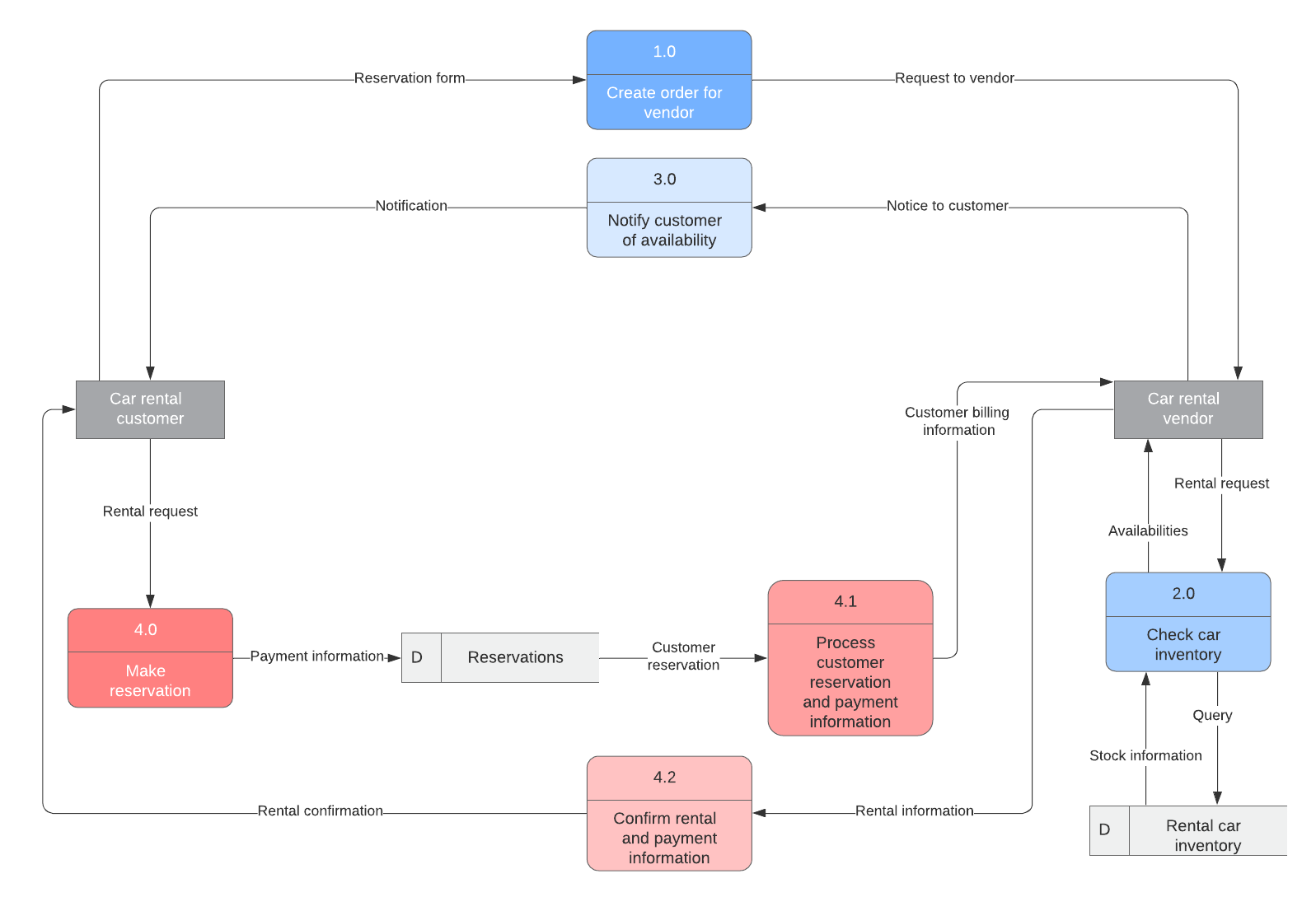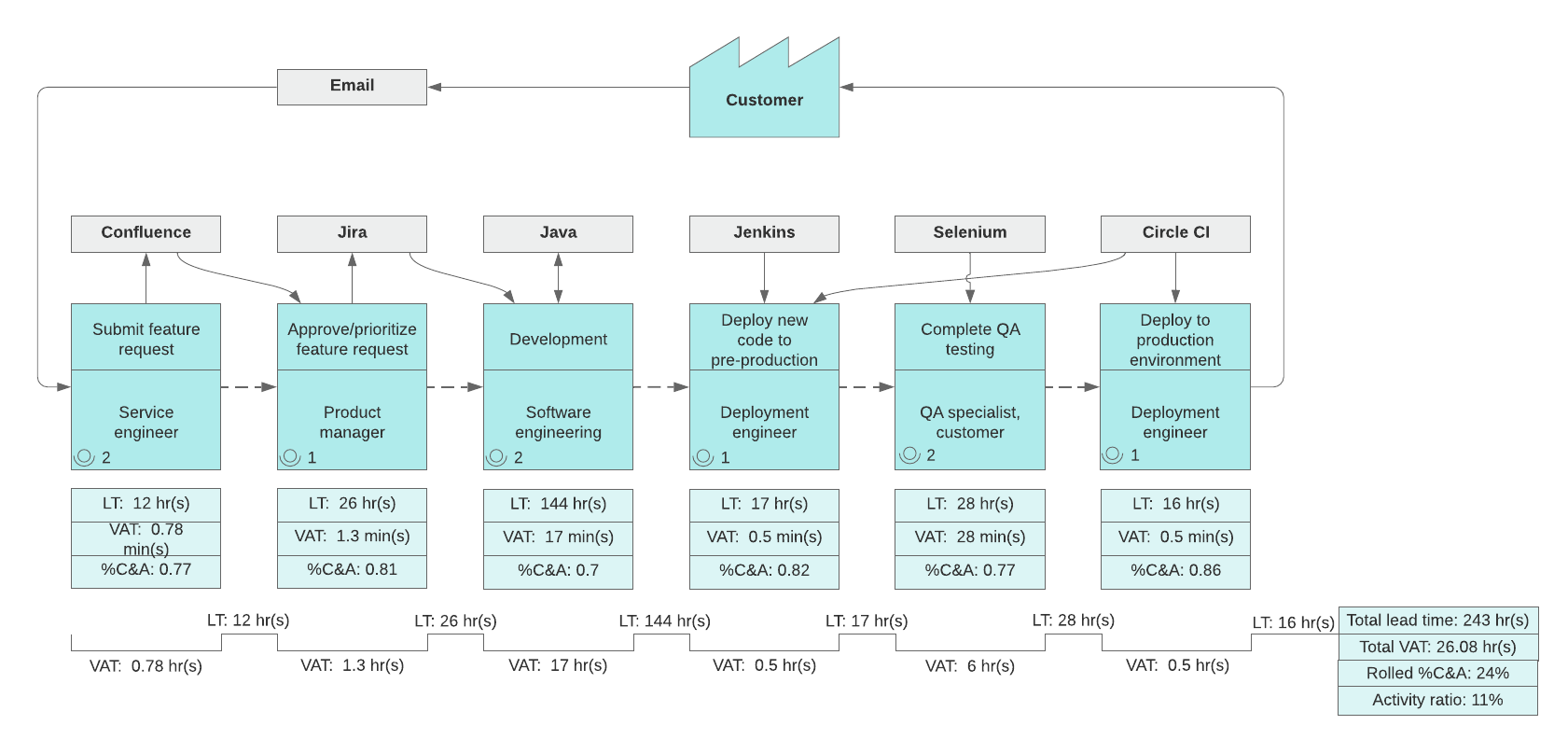
How to manage applications in your end-to-end processes
Lucid Content
Reading time: about 10 min
Relying on many different applications throughout your end-to-end processes adds layers of complexity and overhead. It’s important to determine which are essential, and which simply create more work or complexity than is necessary.
By conducting an in-depth evaluation of—and closely monitoring—your end-to-end processes, you can determine where a process can be improved with or without software, potentially simplifying processes and divesting from expensive and unneeded tools that may be causing more harm than good in your processes.
As you plan process improvements and evaluate workflows, consider breaking down each operational process in order to manage your applications.
Overview of end-to-end processes
End-to-end processes (or EEPs) are part of everyday business operations inside organizations. Defining your end-to-end processes allows you to plan your workflows, improve efficiency, and manage change.
In order to understand how end-to-end processes work and what they are, you can begin by breaking down the process and looking for a starting point and an endpoint. Within a process, you may find a chain of multiple end-to-end processes, or subprocesses.
Complexity increases when multiple applications, triggers, and other pieces of your process operate together or serve as dependencies. For instance, a series of steps could begin in response to a customer or user action. As the process concludes with a successful outcome for the customer, another process might begin. The complexity is such that knowing your processes inside and out is important to having a complete view of your operations.
Looking at your end-to-end business processes can help your organization:
- Troubleshoot: When a process breakdown occurs, knowing the ins and outs of your processes can show you the point of failure faster.
- Benchmark: You can evaluate how well your process is doing and track your progress on targeted KPIs that matter for your goals.
- Optimize: You can’t make improvements to processes without knowing where you currently stand—in-depth process knowledge will help your organization start to optimize.
- Understand user experience and customer journeys: The more you understand the customer journey and touchpoints, the better you can assess your application placement and needs throughout that journey.
- Implement new technologies: With a better understanding of existing applications and processes, you can better assess and select new tools in your tech stack.
- Undergo a digital transformation: Digital transformation can be messy and complex, but with insights into how you already use technology, you can more clearly undergo a digital transformation.
Starting to break down your process should reveal more about its timeline and characteristics. Processes don’t always have obvious beginnings, but they do start with a trigger event.
Where a process begins
Let’s say you’re planning to put on a webinar. The actual webinar itself isn’t where the process begins since you have other, earlier steps that must happen before you can successfully put on your webinar. For instance, you have to check your event’s schedule: Did you already have too many webinars this month, and therefore, would it make more sense to hold this event next month? You also prepare a marketing campaign to get the word out and build a registration list. For your marketing efforts, you may use Marketo, essentially automating part of your webinar process with an application.
Where’s the trigger that leads to a webinar in the first place? Maybe you launched a new product or you’re prepping for a feature launch. The launch could be the trigger for the entire process.
Consider these questions as you look for the beginning of a process:
- Where do I think the process begins? Start here, and then do more digging to determine if that’s where the process actually starts.
- Why does this process happen? Are there multiple triggers for this process, or does it begin with just a single trigger event?
- Where does this process fit into our business operations? Is the process part of a larger workflow?
- Does this process co-occur alongside other processes? Are there any process dependencies to consider documenting along with this process?
Where a process ends
Finding the end of your process is important, too. Without knowing how the process ends, it’s hard to know if the process is accomplishing what you need it to do. If the end result of a process fails, the entire process itself could be invalidated.
Follow the process to find where it ends:
- What outcome do I expect to see when this process is over? Possible outcomes could include the fulfillment of a customer transaction, a last contact with a customer, or the conclusion of a user session.
- What is the final step? What step do you think concludes the process? Is there a step after, or does the process restart later?
Now that you’ve identified the beginning and ending of your process, you can start defining other steps. To determine what other components are important, such as which applications to use, you may need more information.
Other stages in your process
Some process steps may happen simultaneously or begin at different stages, and it’s time to sleuth out what this looks like for each process you analyze.
Workflows and processes can be relatively simple all the way on up to extremely complex, sometimes with thousands or millions of steps. Thankfully, computers can handle complexity. But the human mind can’t. Not to the same degree, anyway.
Thinking about your process, you can find and identify in-between steps by asking the right questions:
- Change control: Are any of your organization’s standards satisfied by steps in this process? Are documents or files modified? A modification or recording action may represent a process step.
- Defect and issue management: Does the process involve responses to encountered errors, defects, or issues that show up during the process?
- Financial and resource controls: As time elapses, does the process involve reporting time? Is resource use reported between applications (e.g., infrastructure and computing resources, physical resources, etc.)?
- Providing instructions: Does an application issue instructions to another or receive instructions?
- Issuing approval: Could an application approve an action, change, or another step?
Some of these steps could be subdivided into additional steps. As complexity increases, the steps involved in processes become more easily understood by computers than by people. If your processes are getting to be more “unruly,” then using software to help you visualize, understand, simplify, and streamline your processes could be valuable.
The role of software and applications in your EEPs
Software can provide more information and data to inform your understanding of and your decisions about end-to-end processes, and vice versa. With help from these applications, you can streamline and improve your processes, implementing improvements quickly and more effectively than you could if you were manually making adjustments to your processes.
From there, you can use applications in support of your processes, automating your workflows and responding to triggers to carry the process forward.
Many different types of software systems are helpful with EEPs, such as:
- Robotic process automation (RPA): Software can complete tasks directly, moving information and doing actions that form steps in a process. RPA allows teams to operate more efficiently.
- Customer management software (CMS): Draw customer data from multiple sources and locations for managing your team’s customer relationships.
- Email service provider (ESP): Using an email marketing platform can make your marketing more efficient and customized for a better user experience.
- Document creation: With software that can automatically generate documents you can customize or populate with unique data, your team can save time on routine docs such as proposals and contracts.
Managing your end-to-end processes lets you adjust your workflow and operations activities. The right approach to EEPs and application management helps you effectively control your processes. Adding applications can give you more control over and flexibility with process automation, as long as you keep in mind that complexity increases with more applications.
Managing application complexity
Toggling between too many different applications can slow down processes or even eliminate the process efficiency you gained from bringing new systems onboard. This is why having good visibility and simplifying application management as much as possible is essential.
How to manage applications in your EEPs
Using integrations
Integrations can assist with managing processes and their associated applications. As you plan your use of integrations, however, take the time to evaluate what these applications contribute to your overall process:
- Tool effectiveness: Are your applications effective? Do you have too few applications involved, or too many?
- Application tracking: Are you manually tracking your applications? Are there integrations to facilitate tracking?
- Licensing: Is application use restricted by the number of licenses your organization has? Does any one department or person control all use of the application?
- Cost of use and licensing: Does the application’s resource use or cost make it more worthwhile for your organization to do the work manually instead?
Managing applications with Lucidchart
Application management with your end-to-end processes means you’ll need access to good, real-time data to create an accurate visual. Lucidchart can help you manage your applications collaboratively and with accurate information.
Testing
Automated processes still require testing like any other processes do, so you’ll need in-depth data and information from your applications. With this data, you can see what the current state of your automated processes looks like and identify trends that should be evaluated or monitored.
Here’s how Lucidchart helps you test your processes:
- Data linking: Connect your data in real time so it flows between your applications and Lucidchart. Gather input from sources such as AWS, Azure, Google Cloud, G Suite, Google Docs, Confluence, Slack, and others.
- Process mapping: Visualize your processes with charts populated by your data. Use custom visuals or pull from Lucidchart’s provided templates.
- Detect issues early: DevOps processes, operations, and other process flows can be checked for problems early on.
Evaluation and monitoring
With an intelligent diagramming application such as Lucidchart, you can locate inefficiencies, monitor changes, and locate performance gaps. For instance, you can use custom shapes and templates to create a workflow map fed with real-time data so you can visualize your progress.
Collaborate with your team or between departments—everyone can see the same data and workflow in Lucidchart:
- Database mapping: Monitor databases and identify problems, unusual activity, or other issues with real-time data.
- Visualize workflows: Automated workflows can be intuitively visualized as part of a chart populated with real-time data.
- Comments: Teammates can make comments on what they see directly in Lucidchart.
- @mentions: Even if your team is fully remote, your teammate can “look over your shoulder” at the same workflow and tag you in a comment or discussion.

Simplifying
Improve upon your automated processes using Lucidchart features:
- Layers: Determine future states, identify opportunities for improvement, and discuss them with your team.
- Value stream mapping: Show a breakdown of all the steps involved in an automated process and find out how much time and resources are spent at each stage.
- Customer journey mapping: Craft an improved customer experience by visualizing how customers interact with your product from discovery to use.

Understand processes and automation with Lucidchart
With the process toolkit Lucidchart provides, you can manage your automation and business processes in real time and collaborate with others. These tools can help you improve your existing processes and manage change in your organization.
Software visualizations and process mapping may simplify some elements for the human eye. When you create a diagram, you may need to be strategic about what to include and what not to. Visualizations are often big-picture tools that illustrate. As needed, you can always drill down to detail—Lucidchart, for instance, allows you to zoom in and out on process components.
Digital transformation and transition have a lot to offer—making the most of the digital landscape requires having the balance of technology and process.

Visualize and manage your end-to-end processes and technical systems in Lucidchart.
Learn moreAbout Lucidchart
Lucidchart, a cloud-based intelligent diagramming application, is a core component of Lucid Software's Visual Collaboration Suite. This intuitive, cloud-based solution empowers teams to collaborate in real-time to build flowcharts, mockups, UML diagrams, customer journey maps, and more. Lucidchart propels teams forward to build the future faster. Lucid is proud to serve top businesses around the world, including customers such as Google, GE, and NBC Universal, and 99% of the Fortune 500. Lucid partners with industry leaders, including Google, Atlassian, and Microsoft. Since its founding, Lucid has received numerous awards for its products, business, and workplace culture. For more information, visit lucidchart.com.